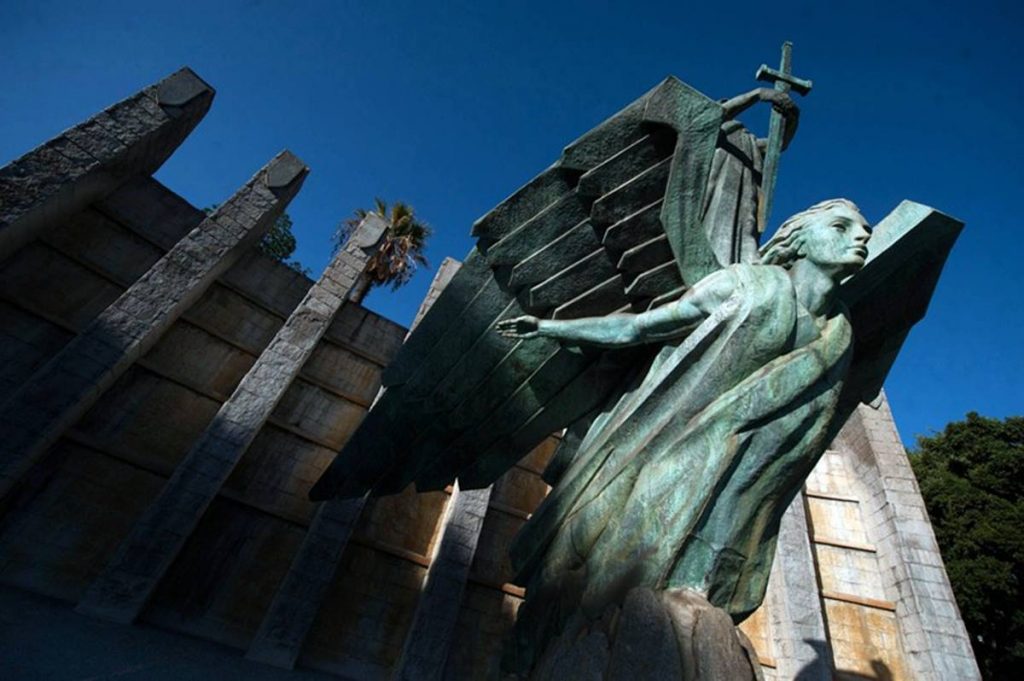
The Vice-Ministry of Culture and Cultural Heritage has concluded the work of preparing the Catalog of Francoist vestiges of Santa Cruz de Tenerife, a document that over three thousand pages exhaustively and rigorously records these elements in the island’s capital and that now it must be approved by the Ministry of Education, Universities, Culture and Sports, after being informed by the Technical Commission of Historical Memory. The investigation has been led by the professor of History, Maisa Navarro, together with expert doctors Ricardo A. Guerra Palmero and Yolanda Peralta Sierra.
The General Directorate of Cultural Heritage, finalizes the Catalog of Francoist symbols, streets, monuments and mentions of the municipality of Santa Cruz de Tenerife, as established by Law 5/2018, of December 14, on the historical memory of the Canary Islands and recognition and moral reparation for the Canarian victims of the civil war and the Franco dictatorship.
Juan Márquez, Deputy Minister of Culture and Cultural Heritage, insists that “all public administrations have the obligation to comply with regional and state law” and stresses that in “the recognition and reparation of the victims of Francoism, all democrats must commit ourselves” .
The catalog of the capital of Tenerife includes a collection of almost 80 cards relating to monuments, sculptures and objects, Francoist mentions applied to street names, spaces and urban elements, as well as buildings and a list of honors and distinctions awarded at different times of the Corporation history.
In addition, this catalog presents other specific objectives, provided for in Law 5/2018, of December 14, on the historical memory of the Canary Islands and on the recognition and moral reparation of the Canarian victims of the civil war and the Franco dictatorship, among them, developing the contents defined in articles 12, 16 and 17 of the law, with regard to activities leading to the creation of the Virtual Documentary Center of the Historical Memory of the Canary Islands (Article 16); the creation of curricular content for inclusion in Primary, Secondary and Baccalaureate Education aimed at disseminating the principles and values expressed in the law (Article 17); the preparation of content for inclusion in university degrees (Article 17); as well as the promotion of scientific research on such content (Article 17).
In the preparation of this document, the investigation commissioned by the City Council of Santa Cruz de Tenerife and delivered to that administration on July 2, 2019, has been taken into account, to guide municipal actions due to the case initiated against the corporation in 2017 and ratified in May 2018 for non-compliance with the 2007 Historical Memory Law. The research team was also constituted then by Dr. María Isabel Navarro, as Principal Investigator, and with the participation of Dr. Ricardo Guerra Palmero and the researchers Fácil Perdigón Pérez and Dailo Barco Machado.
The Catalog of Francoist vestiges of Santa Cruz de Tenerife
The Catalog is the tool that allows you to act with each specific case. For its preparation, documentary research has been carried out in archives of local administrations, regional administrations, State administrations and military archives related to the concepts contained in Law 5/2018, updated research on bibliographic sources and technical documents related to the concepts of Memory, Historical Memory and History of Art, and, particularly, the most recent documents made by various Spanish administrations in different autonomous communities.
On the other hand, it has texts corresponding to the History and Historical Memory of the Canary Islands, review of information corresponding to iconographic, photographic, sound and audiovisual documents, as well as the preparation and supervision of information for the Catalog of Franco’s symbols, streets, monuments and mentions of the Autonomous Community of the Canary Islands.
Regarding the concepts defined in the cataloging, an identification of vestiges present in the municipal term consisting of: monuments; sculptures and objects; gravestones, plaques and inscriptions; names of streets, names of spaces and urban elements, names of buildings and honors and distinctions.
Each file contains data of interest regarding the year, the denomination, the type of vestige, the location, the site map, the organization or entity, the inscription, a description, graphic documentation, the historical context, a justification, the sources and observations. In this last section, the removal of the almost 80 vestiges that are still preserved related to the Franco regime is argued.
Among the vestiges that must be definitively removed from public space are monuments such as the Monument to the Fallen (1947) and the Monument to the Caudillo (1966), sculptures such as the bust of Joaquín Amigó de Lara (1986) or objects such as the propeller of the Crucero Canarias, inscriptions such as the plaques of the National Housing Institute (1957) or the tombstone of the Fallen of Igueste de San Andrés (1975).
As for the denominations, we find roads such as the General Serrador bridge (1943), Calvo Sotelo street (1936) or the Francisco Aguilar y Paz promenade (1994) as well as neighborhoods such as the Victoria neighborhood and square and educational centers such as the CEIP Fray Albino (1944), among others. The honors and distinctions include more than 130 people.
















